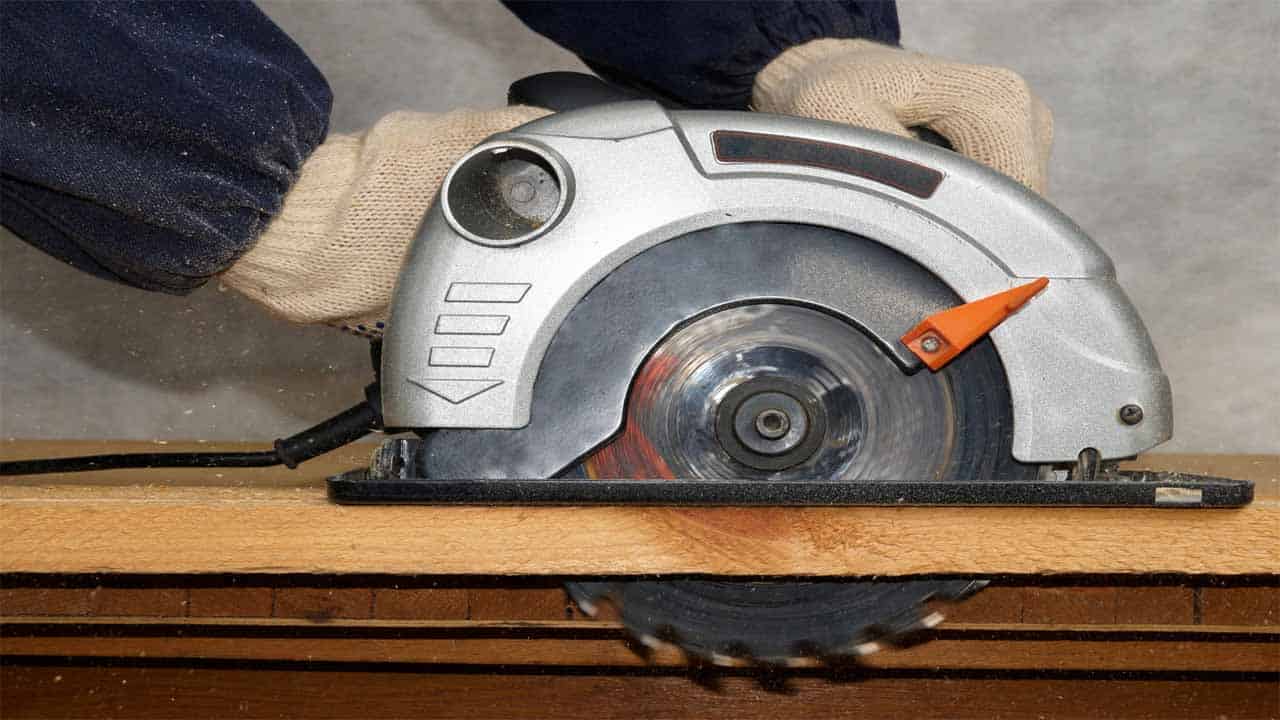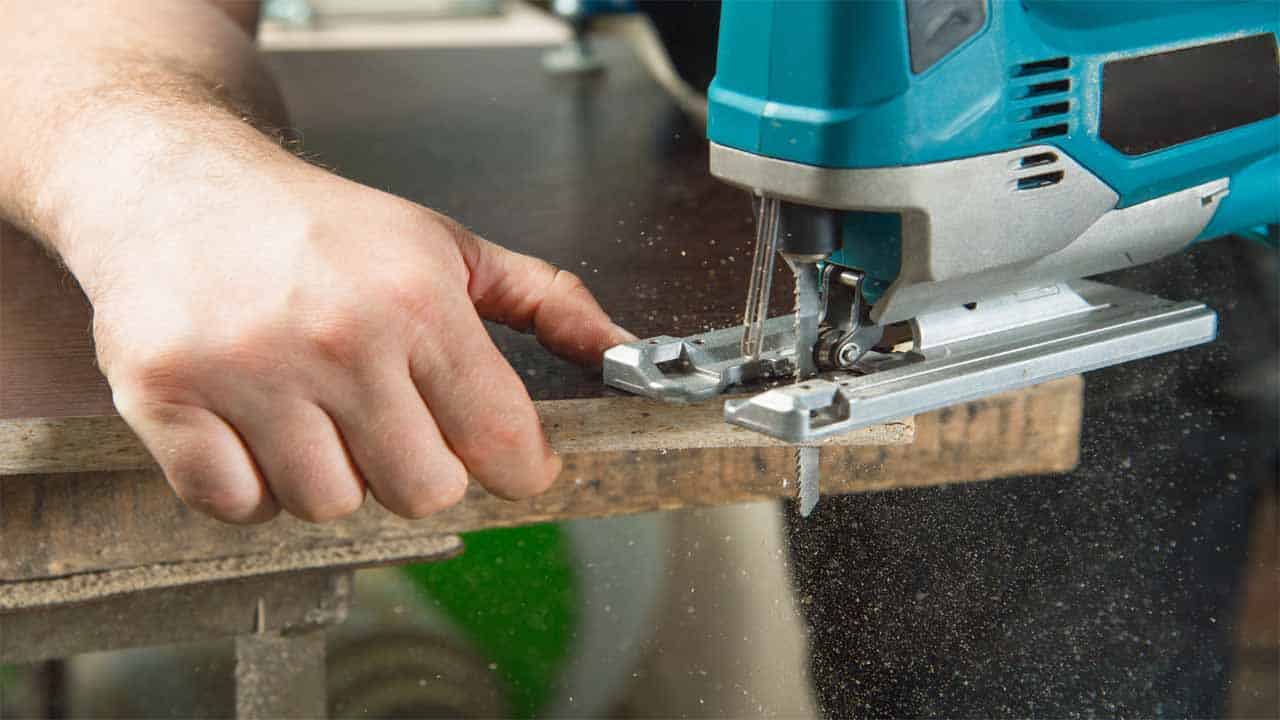Circular Saw vs Jigsaw (7 Differences Explained)
TheToolGeeks.com is a participant in the Amazon Services LLC Associates Program and other affiliate advertising programs. We may earn from qualifying purchases. (Learn More).
Either you are a woodworker that is just starting your woodworking journey or you are a DIYer who is looking for a power saw to tackle home improvement projects, one thing is for sure.
You need a power saw that is convenient to use. When it comes to picking your first power saw as a beginner, convenience and easy usage are a priority.
Though there are many power saws out there that fall into the beginners’ power tool category, two power saws stand out. The jigsaw and the circular saw.
Both saws are easy to use, they are both suited for woodworking and home improvement tasks, and they are both suited for beginners and DIYers. So which of these power saws should you buy? Well, that answer depends on several factors.
Luckily, this post will introduce you to and explain all you need to know about the circular saw vs jigsaw as well as tips to help you figure out which of the two you will need for your task. So let’s get on with it. First, let’s take a look at Circular saws.
What Is a Circular Saw and What Is It Used for?
A circular saw is a handheld power saw capable of making several cuts at varying depths. Circular saws are very versatile power saws used by both beginners and professionals for making cuts along and across materials.
The saw comes in both corded and battery-powered models. Circular saws are also used by construction workers because of the saw’s power and lightweight which makes it very mobile.

There are different types of circular saws and they vary based on their sizes, function, and brand. Though there are many types of circular saws, one thing that unites all circular saws is their blade.
Circular saws use a thick circular carbide blade with teeth to make cuts. The blade is spun repeatedly by a powerful motor located within the saw.
Circular saws also have different types of blades. Each blade with its size, thickness, and several teeth. Each circular saw blade is suited to a different task. Rip blades for instance are used to cut along the grain.
Crosscut blades on the other hand are used to cut across the grain, and combination blades are used to cut along and across the grain. Circular saws are designed with several features like a blade adjustment knob, a blade guard, and the likes that make its usage easier.
In terms of cutting function, circular saws are used to cut a wide array of materials ranging from wood to plastic and even metal. The main strength of the circular saw is its power. Now, let’s take a look at jigsaws.
Related Read — Best Battery-Operated Circular Saws
What Is a Jigsaw and What Is It Used for?
Jigsaws are also handheld power saws and they look like a pressing iron. Jigsaws are popular for the saw’s ability to make curved cuts and shapes on materials including wood and light metal. Jigsaws use a thin and short blade with teeth to make cuts.
The blade is positioned below the jigsaw and it cuts materials in an up and down motion. The motion of the blade is similar to the motion of a needle on a sewing machine.

The blade is powered by a motor located within the saw. The motor controls the motion of the jigsaw and some modern jigsaws have a speed control knob that can be used to increase the cutting speed of the power tool.
Jigsaws also have different types of blades. The blades of a jigsaw are differentiated based on their length, thickness, and teeth. The tiny blades are used for precision cutting.
Thin jigsaw blades are used to cut intricate shapes and make designs on wood. Thicker and longer blades on the other hand are more suited for rough work. This is because jigsaw blades that are designed with small teeth will make smoother cuts than the blades designed with bigger teeth.
Jigsaws also come in battery-powered jigsaws and corded models. The saw is popular among craftsmen and woodworkers that work with details, designs, and shapes.
The biggest advantage of the jigsaw is its ability to make curves and shapes. Jigsaws can even cut circles on wooden boards. Isn’t that fascinating? But how great is a jigsaw compared to a circular saw? Let’s find out.
Circular Saw vs Jigsaw: Head to Head
Both the circular saw and the jigsaw are amazing power tools. Both have great cutting action and they both have advantages and disadvantages.
However, when it comes to buying one, it is a good idea to know where both saws stand when compared to each other. So let’s do a vivid comparison.
The Blade
Since we are comparing power saws, there is no better feature to start with than the blade of the saw since that is what makes the cut. When it comes to the blade, both saws have more apart than they do in common. Perhaps the only aspect of the blade that both saws have in common is that both power saws have their blades located beneath the power saw. so let’s check out the differences.
Circular saws use a thick circular carbide blade to make cuts on different materials while jigsaws make use of a short, straight, and thin blade to make cuts.
The blade of a circular saw is thicker than the blade of a jigsaw. Though both blades have teeth, the teeth on a circular saw blade are more than the teeth on a jigsaw blade. Even the circular saw farm blade that has the fewest teeth (20) still has more teeth than most jigsaw blades.
Asides from the teeth, jigsaw blades are also more prone to damage than circular saw blades. Because of the thin and narrow structure of the jigsaw blade, the blade can break while cutting. This especially happens when cutting thick materials like steel and ceramic. Though jigsaws have blades specially built for tough materials, the blade due to its structure can break.
Circular saw blades, on the other hand, are much thicker which means it rarely breaks. The worst-case scenario with your circular saw blade is if the blade gets worn out or the teeth start to chip.
The blade of a circular saw would not break regardless of how frequently you use it. This gives circular saw blades increased durability marking them last longer than jigsaw blades. Let’s check out another feature.
Related Read — Best Electric Circular Saws
Power
When it comes to power saws, one major factor to consider before buying a saw is how powerful the saw is. A saw’s power will determine the type of materials it can cut as well as how well the power saw can work.
In terms of power, circular saws are more powerful than jigsaws. If you have a jigsaw, the tool wouldn’t help much when you have large jobs on your hands. Jigsaws are more suited to small-scale tasks and lighter materials. Though the jigsaw can cut some metal, it is more suited for cutting plastic, wood, and pipes.
Circular saws on the other hand are a whole different ball game. Circular saws are one of the most powerful handheld saws you will find in the market.
The power of the saw is why you find it in the hands of Jobsite workers and construction workers. Circular saws can cut different materials with ease and can also cut thick boards and lumber.
One major reason for the increased power of a circular saw is its motor. The circular saw features a very powerful motor. This coupled with a thick carbide blade very much explains why the circular saw is very powerful. Though jigsaws aren’t as powerful as circular saws, they also have their strengths. Keep reading to know more.
Related Read — Jigsaw or Sabre Saw
Versatility
Versatility refers to a saw’s ability to make different types of cuts. When it comes to versatility, jigsaws rule. What the jigsaw lacks in terms of power, it more than makes up for in terms of versatility.
Jigsaws are incredibly versatile power tools. In addition to making the standard straight cuts, jigsaws can also make curved cuts, bevel cuts, and plunge cuts. Jigsaws are also used to cut shapes, letters, figures, and even make designs on wood.
Jigsaws are also very handy when cutting in tight spaces. The position and thin structure of the blade makes the saw capable of cutting in tight spaces. This is why jigsaws are common tools in the hands of plumbers and electricians that deal with pipes and wires in enclosed spaces.
Circular saws on the other hand are not so versatile. Though it’s fair to state that in the hands of an expert, circular saws can also make some intricate cuts but not with the level of ease as a jigsaw.
Circular saws are restricted to making straight cuts and square cuts along and across wooden boards. This means circular saws aren’t exactly versatile. If you want an all-purpose power saw, the jigsaw is your best bet because of its versatility. Let’s check out another feature.
Speed
Another important factor to consider is speed. As you have probably guessed, circular saws are way faster than jigsaws.
Circular saws can reach speeds of over 5000 RPM (revolutions per minute) and some corded circular saws have been discovered to reach speeds of about 6500 RPM.
In case you don’t know that’s a lot. Jigsaws on the other hand can reach speeds of about 3000 SPM (strokes per minute) at best.
Size and Weight
Since both saws are handheld saws, the weight, and size matter because that is what will determine if the saw is handy or not. In terms of the size and weight, both saws are very light though the jigsaw is a tad lighter.
Jigsaws weigh between 3 pounds and 10 pounds depending on the brand and model you buy. On average, a jigsaw weighs about 6 pounds which makes the saw very handy and convenient to use.
Circular saws though also lightweight still weigh a bit more than jigsaws. Circular saws weigh between 5 pounds and 15 pounds depending on the brand and model you buy.
On average, a circular saw weighs about 9 pounds which for the record is still very light. For both saws, the model and brand determine the weight.
Battery-powered models usually weigh more than corded models because of the extra weight of the battery which can be about 2 or 3 pounds on its own. In terms of size, the circular saw is also bigger than the jigsaw.
Precision and Accuracy
In terms of precision and accuracy, jigsaws rule this world ahead of circular saws. Jigsaws are more common in areas where precision matters.
The increased precision of a jigsaw is a result of the structure of the blade. Jigsaw blades can even make shapes like circles in wood. Another reason why the jigsaw is more accurate than the circular saw is because of its lighter weight and build.
As stated earlier, jigsaws look like a pressing iron and on average, weigh about 6 pounds. This makes it easier to move and tilt the power saw for careful movement. This is not to say circular saws aren’t accurate.
In its own right, the circular saw is fairly accurate. Circular saws can make different cuts with a nice level of accuracy through the accuracy can’t compare to that of the jigsaw.
Circular saws are more suited to rough cutting and rip cuts. Though the accuracy of a circular saw can be improved by building a rail, that modification will come at an extra cost.
Related Read — How to Make Curved Cuts With a Jigsaw?
Difficulty
Both the circular saw and the jigsaw are categorized as beginner’s power tools because the saws have a low level of difficulty. But which is easier to use?
The jigsaw is easier to use than the circular saw. Jigsaws have fairly moderate speed and the saw is also lighter than a circular saw. This makes the saw easy to use most times without any prior experience. The accuracy of the jigsaw also makes it easy to achieve great cutting results with the power saw.
Circular saws on the other hand are not as easy to use as jigsaws. For starters, circular saws are very fast and the increased speed can cause kickbacks.
The intense speed of the circular saw coupled with its weight and larger size doesn’t make it the easiest power tool to use.
Don’t forget that the circular saw is also more powerful than the jigsaw. In the hands of a beginner, a jigsaw is a better tool as a first choice power saw. Circular saws need a level of experience before you can operate them.
Related Read — How to Make Straight Cuts With a Circular Saw?
Should You Get a Circular Saw or a Jigsaw?
It all boils down to this question. Now that you know the differences between the circular saw vs jigsaw, which of the saws should you get? Though the answer to this question ultimately depends on you, your answer will be influenced by a few factors. Let’s examine these factors.
Your Level of Experience and Skill
It is always advised to go for a power saw that you have previous experience with or one that you have used before.
However, if you haven’t used either of these power saws before, I will advise you to go for a jigsaw. Jigsaws are much more user-friendly. Circular saws usually require a deal of experience to use because of the increased speed and power.
Your Budget
How much are you willing to spend on a new power saw. If you want a pocket-friendly option or you are trying to save cost, then you should get a jigsaw since jigsaws are less expensive.
However, if you don’t mind spending more, you can get a circular saw. Any of the two will be a valuable addition to your workshop.
Your Task
Another important factor to consider before buying a power saw is the task you need it for. If you are a DIYer who is looking to buy a power saw for household projects and simple tasks, you can get a jigsaw.
Jigsaws are all-around power saws that would be capable of making the needed cuts for simple household tasks. Also, if you want a power saw for making intricate cuts and designs, a jigsaw should be your pick.
However, if your task involves ripping boards, making straight and square cuts or you just need a powerful saw, the circular saw should be your pick.
Circular saws are also more suited for large-scale tasks or tasks that involve cutting large boards and sheets. It’s a classic battle between the precision of the jigsaw and the power of the circular saw.
So there you have it. Hopefully, you have all the information you need to know the differences between the circular saw vs jigsaw. If you have any questions or comments about the topic, please leave them below and I’ll attend to them as soon as possible. Have a nice day.
Amazon and the Amazon logo are trademarks of Amazon.com, Inc, or its affiliates.

